Florida’s Annual Vehicle Shipping Volume
Florida ranks among the busiest states in the U.S. for car shipping, driven by a combination of relocations, seasonal snowbird migrations, and rapid population growth. The state’s highways and ports see a steady flow of vehicles moving in and out, making Florida a cornerstone of the national auto transport market.
- Florida in the Top 3: Alongside California and Texas, Florida consistently ranks in the top three states for total vehicle shipping volume.
- The Nation’s Busiest Route: The New York-to-Florida lane is the busiest car transport route in America, with the return trip from Florida to New York ranking second.
- Massive Annual Moves: Tens of thousands of cars are shipped into Florida every year, with demand surging during peak moving and snowbird seasons.
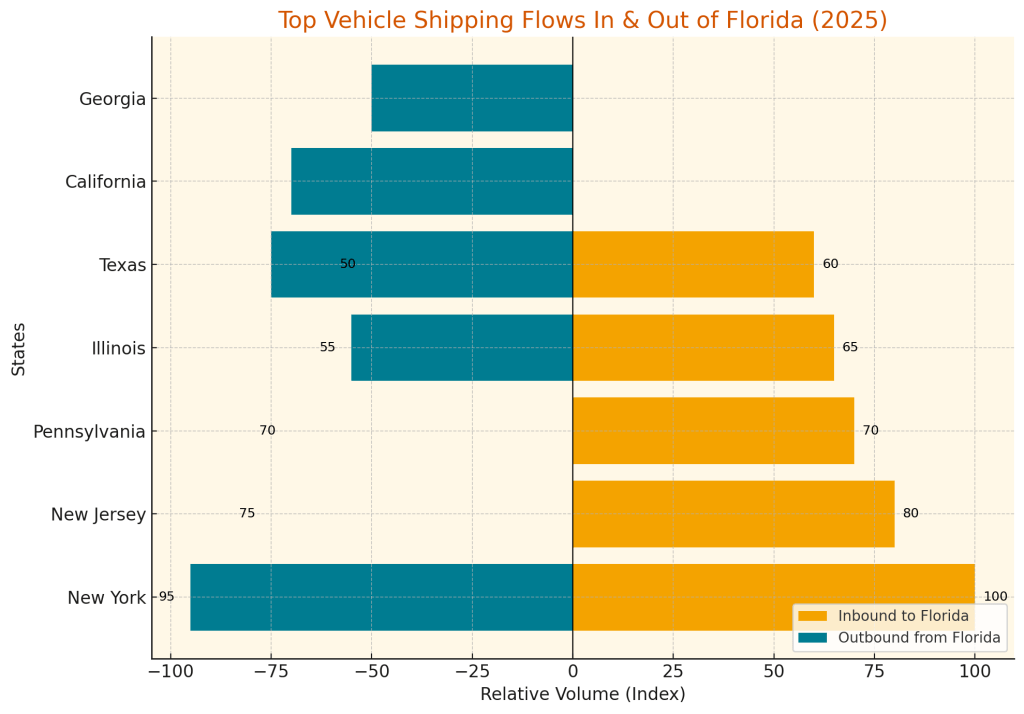
Seasonal Car Shipping Trends
Florida’s auto transport market follows a highly seasonal rhythm. Every fall and winter, retirees and “snowbirds” from colder states ship their vehicles south to avoid icy roads, and in spring, they ship them back north. This seasonal surge makes Florida one of the clearest examples of how climate and lifestyle impact shipping demand.
- Winter Surge: Shipments into Florida rise about 15% in the winter months compared to the yearly average, as seasonal residents head south.
- Spring Return: Many of those identical vehicles head back north by April and May, creating a reverse shipping wave.
- Peak Months: October through early December are the busiest for Florida-bound cars, while late March through May see the highest outbound volume.
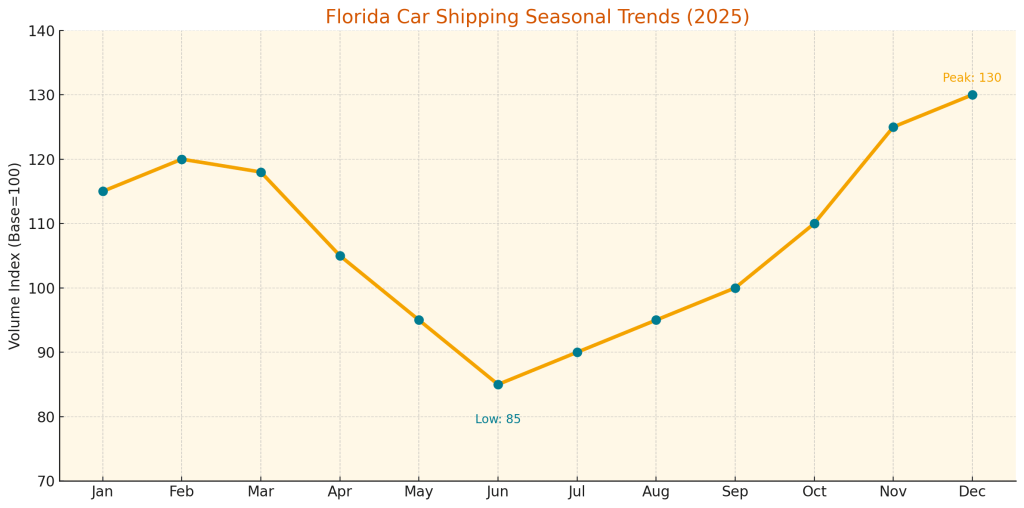
Vehicle Types Shipped
Florida’s car shipping industry handles everything from compact sedans to luxury SUVs, but certain vehicle types tend to dominate. The state’s mix of retirees, families, and seasonal travelers means there’s a predictable pattern in what gets loaded onto transport trailers.
- SUVs Lead the Way: Nearly half of all vehicles shipped to and from Florida are SUVs, reflecting their popularity for families and snowbirds.
- Sedans Are Second: Sedans account for roughly 30% of Florida’s shipped vehicles, often tied to relocations and everyday driving needs.
- Trucks & Vans: Pickup trucks, vans, and specialty vehicles make up the remainder, with pickups being a frequent choice for moves to rural or coastal areas in Florida.
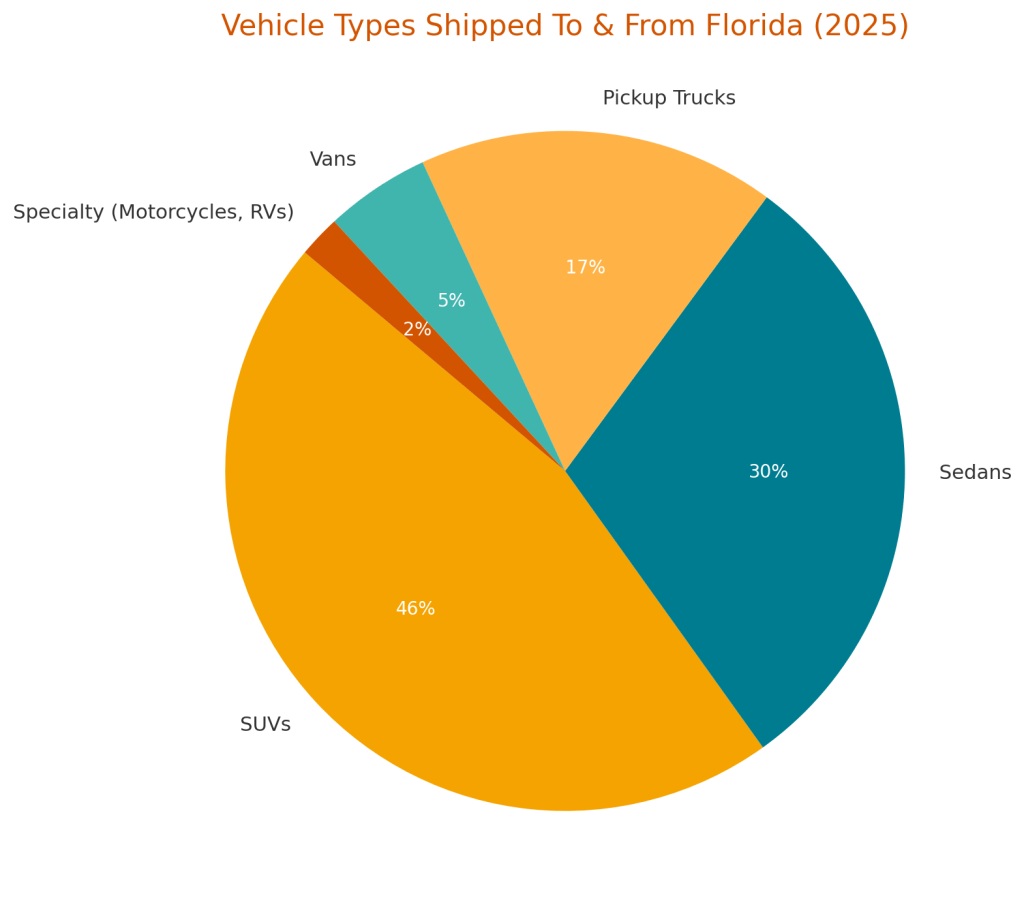
Top Origins & Destinations
Predictable patterns shape Florida’s car shipping network. Most vehicles heading into Florida come from the Northeast and Midwest, while outbound shipments often return to those same states or move cross-country. These flows are driven by retirees, seasonal “snowbirds,” and long-distance relocations.
- New York–Florida Corridor: The busiest car shipping lane in the nation is New York to Florida, and the reverse route ranks second.
- Northeast Supply: New Jersey, Pennsylvania, and Massachusetts are also significant sources of cars heading to Florida each year.
- Outbound Mix: Vehicles leaving Florida often go back to the Northeast, but also west to Texas and California for job or family relocations.
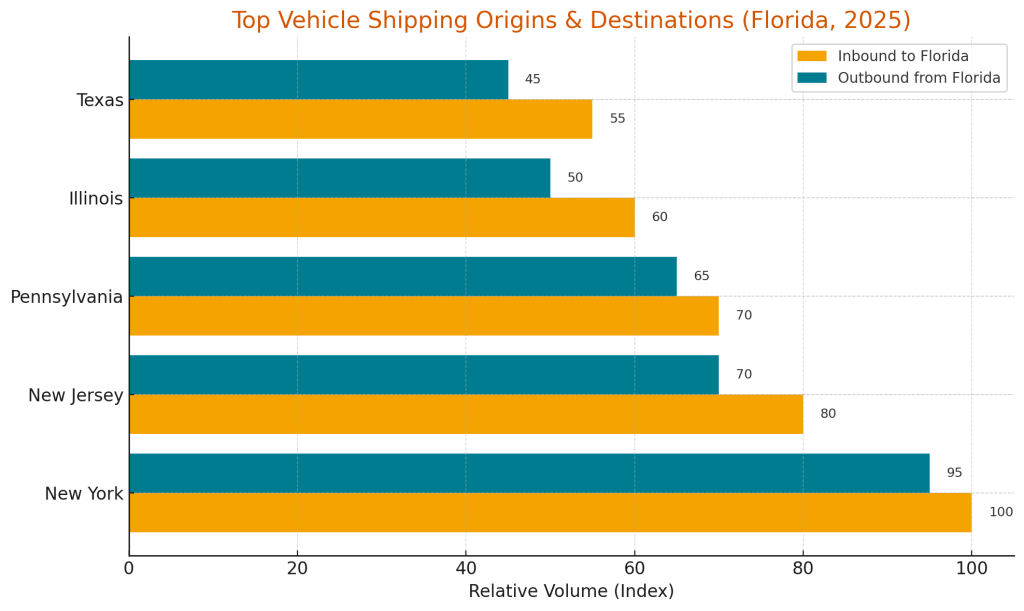
Auto Transport Costs
Car shipping costs to and from Florida vary based on distance, season, and shipping method. Routes like New York to Florida are priced differently than cross-country moves, and prices swing up during snowbird season when demand spikes.
- Average Rate: Shipping a single car costs around $0.60–$0.70 per mile for most routes.
- Multi-Car Discounts: Shipping 3–6 vehicles together can reduce costs by 20–25% per mile because carriers optimize trailer space.
- Seasonal Impact: Rates peak in late fall and early summer, then soften slightly in off-peak months.
- Long vs Short Routes: Long hauls like Florida–California cost less per mile than short trips like Florida–New York, even if total price is higher.
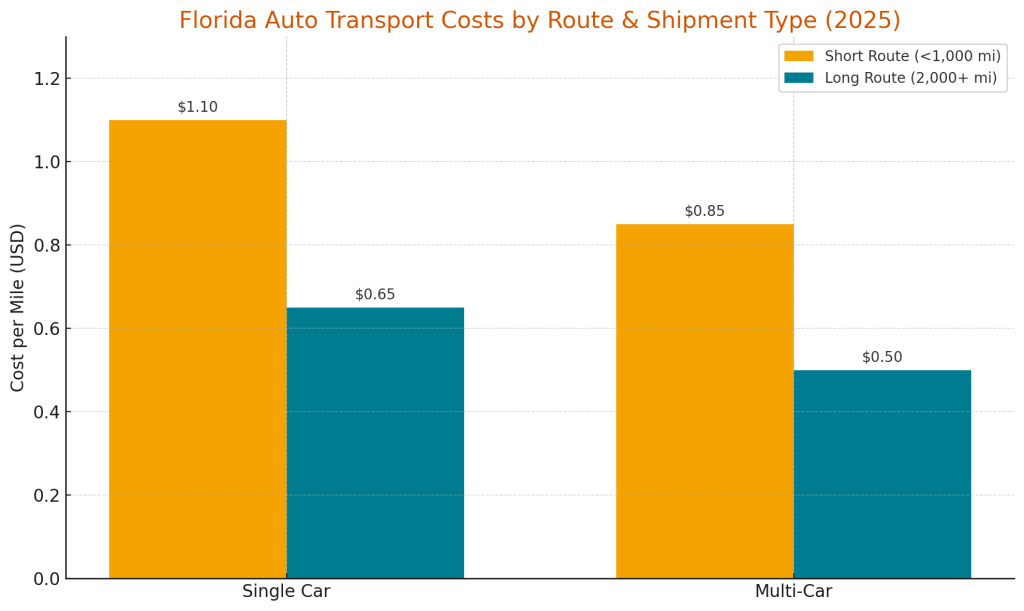
Transport Methods (Open vs. Enclosed)
Most cars shipped to and from Florida travel on open carriers — the familiar two-level trailers you see on highways. A much smaller portion ride in enclosed carriers, which offer extra protection for luxury or classic cars but come at a premium.
- Dominant Choice: Approximately 97% of shipments utilize open carriers, making them the industry standard in Florida.
- Enclosed for Special Cars: Only around 3% of shipments use enclosed trailers, typically for high-end, antique, or collector vehicles.
- Cost Premium: Enclosed shipping costs approximately 50% more than open transport due to limited capacity and specialized handling requirements.
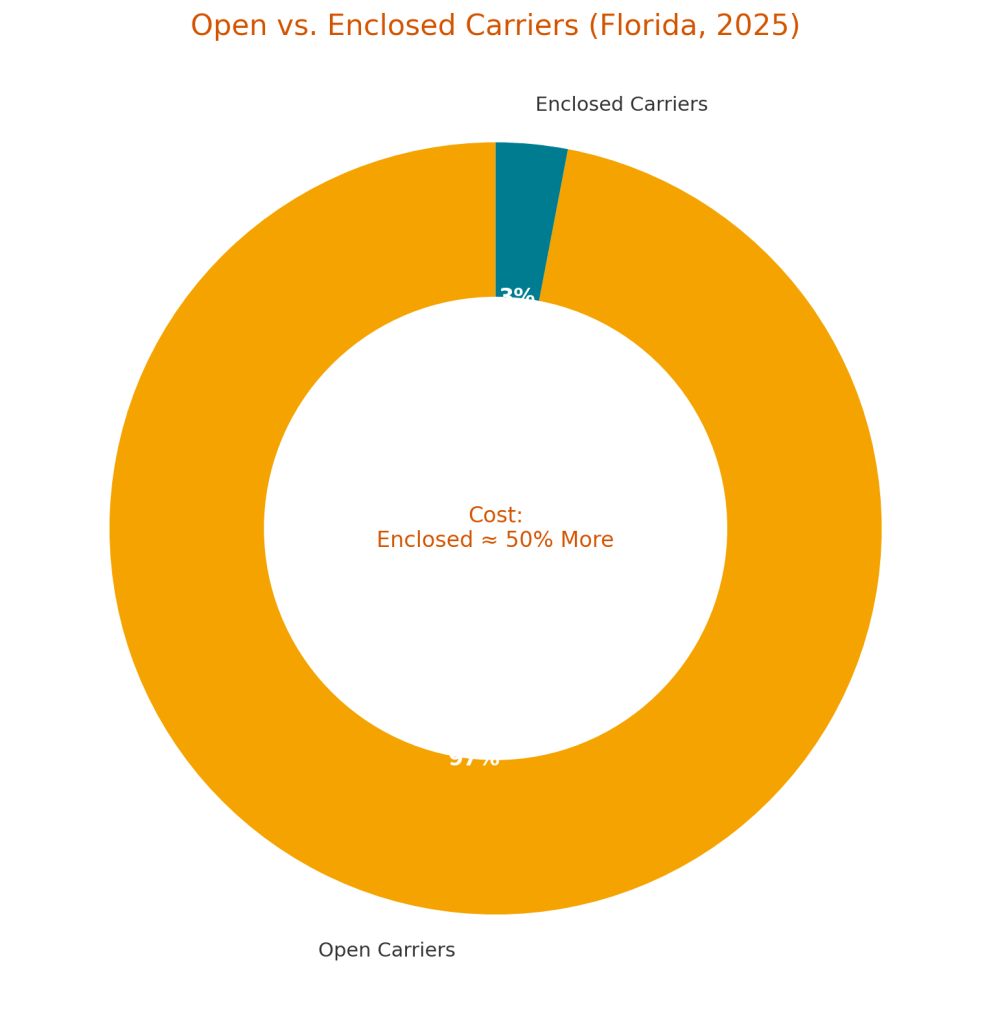
Port Auto Transport Activity
Florida’s ports play a massive role in the state’s car shipping economy, especially Jacksonville’s JAXPORT, which is one of the busiest vehicle ports in the U.S. Most of these vehicles are exports heading to Latin America and the Caribbean. Still, there’s also a steady stream of imports for dealerships across the Southeast.
- JAXPORT Leads: Jacksonville handled over 550,000 vehicles in 2024, making it Florida’s top auto port.
- Export Heavy: Approximately 90% or more of the vehicles at JAXPORT are exports, primarily used cars shipped to Latin America.
- Other ports, such as Miami and Port Everglades, handle smaller volumes, focusing on niche markets.
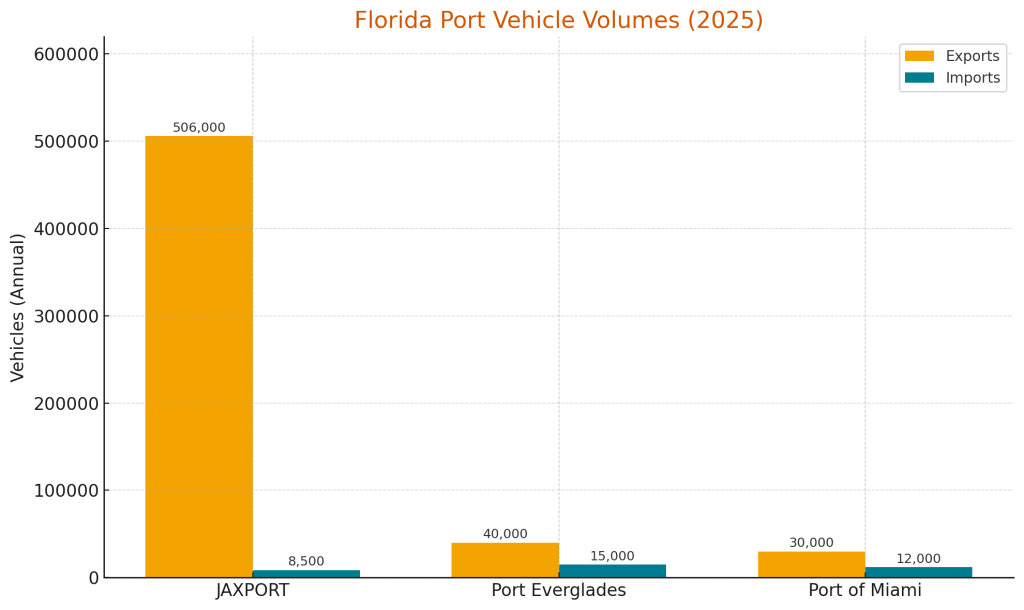
Florida Regulations Impacting Auto Transport
Florida’s regulatory environment is generally trucking‑friendly, but auto transport carriers and customers still need to follow a few essential rules. From weight limits to weigh stations, these regulations ensure safety and compliance on Florida roads.
- Weigh Stations: All commercial trucks over 10,000 lbs must stop at Florida weigh stations.
- Length Limits: Auto carriers can be up to 80 ft long, with small allowances for vehicle overhangs.
- Emissions: Florida does not require annual emissions testing; however, it does enforce anti-tampering laws on emissions equipment.
- Insurance: Carriers must carry DOT‑compliant insurance; new residents must register shipped vehicles within 30 days.
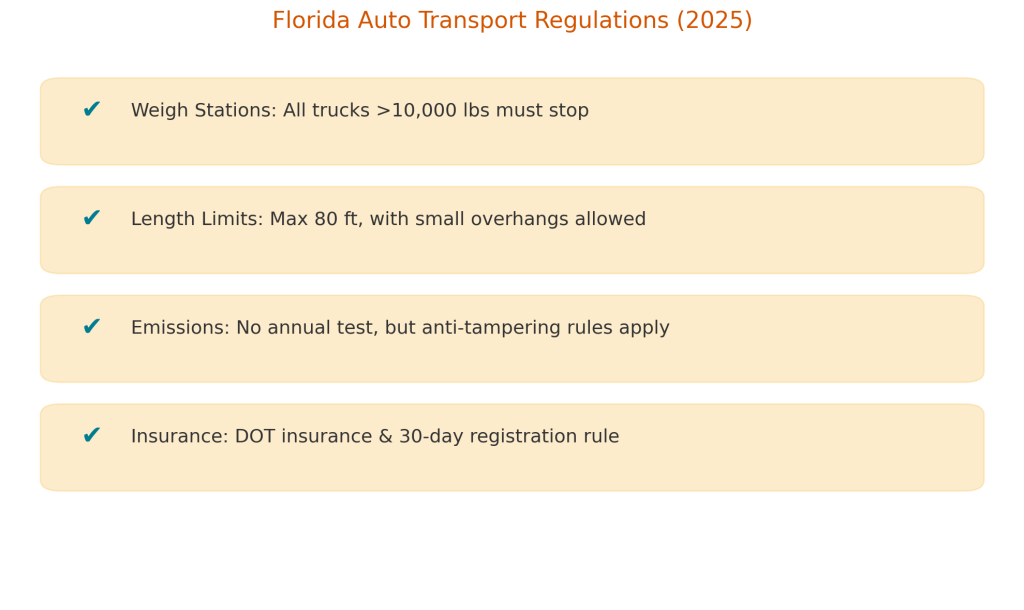
Conclusive thoughts
Florida’s auto transport industry is one of the most active in the nation, shaped by its booming population, heavy seasonal migration, and major shipping ports. Cars flow into the state by the tens of thousands every winter as retirees and snowbirds escape the cold, and then head back north each spring.
Open carriers dominate Florida’s transport landscape, hauling everyday sedans, SUVs, and pickups, while enclosed carriers handle the rare high‑end or collector car. At the same time, ports like JAXPORT drive massive export volumes, sending vehicles overseas and further cementing Florida’s role in the global auto shipping network.
For carriers and customers alike, the state’s simple regulatory environment makes shipping straightforward; however, understanding peak seasons, costs, and best practices can lead to significant savings. In short, Florida isn’t just a destination for people; it’s a hub for vehicles, and the trends of 2025 show that its influence on U.S. auto transport will only keep growing.

